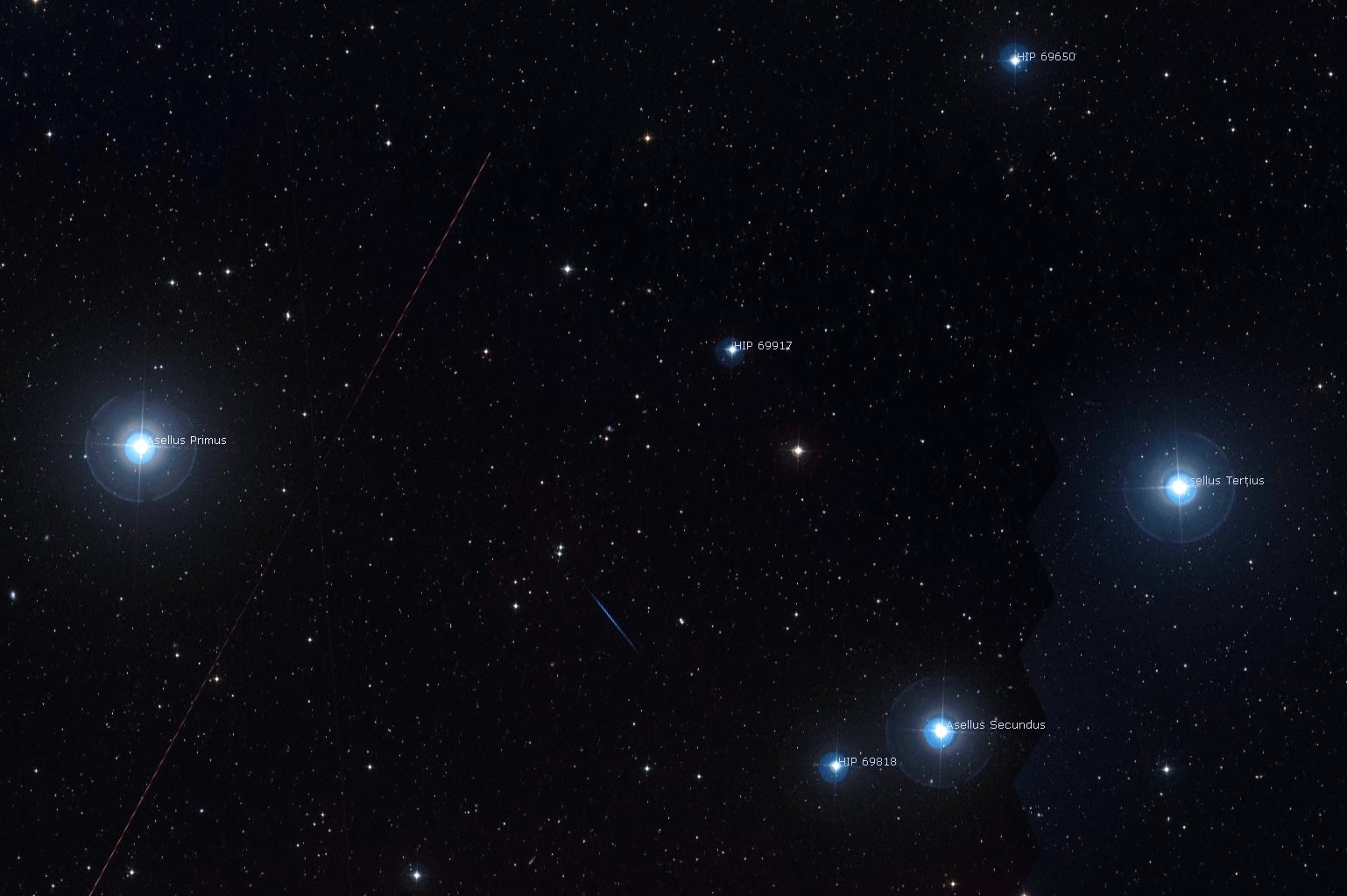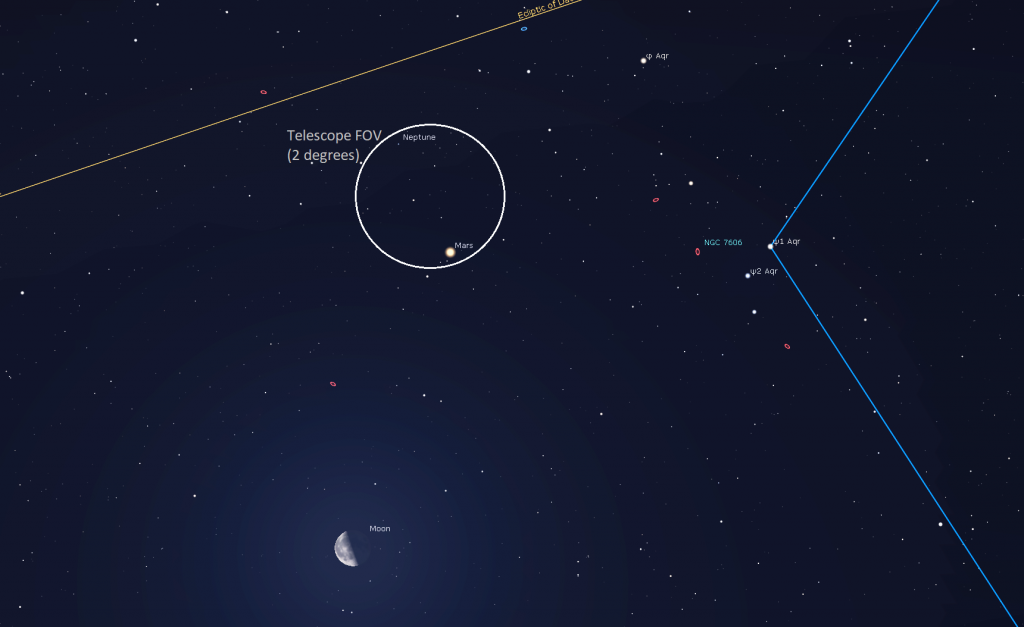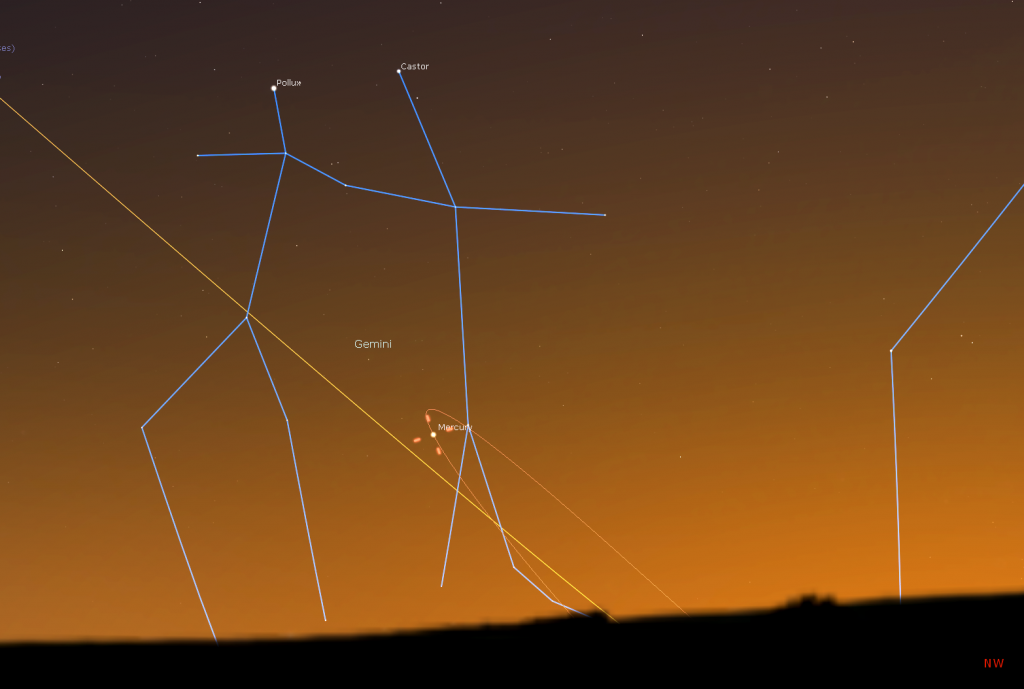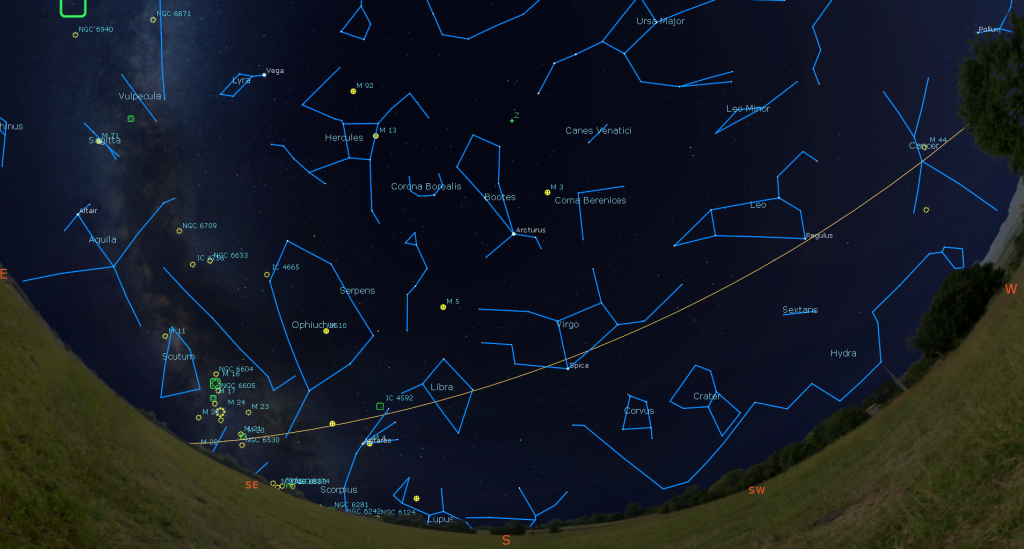The Waning Moon Plays Tag with Planets After Midnight, Leaving Evening Skies Dark for the Treats of Boötes, and Red Mars Buzzes Blue Neptune!

A photograph of the multiple star Asellus in Boötes, from Stellarium’s digital sky survey (DSS).
Hello, June Stargazers!
Here are your Astronomy Skylights for the week of Jue 7th, 2020 by Chris Vaughan. Feel free to pass this along to your friends and send me your comments, questions, and suggested topics. You can also follow me on Twitter as @astrogeoguy! Unless otherwise noted, all times are expressed in Eastern Time.
I can bring my Digital Starlab portable inflatable planetarium to your school or other daytime or evening event, or teach a session online. Contact me through AstroGeo.ca, and we’ll tour the Universe or the Earth’s interior together!
For skywatchers the world over, the moon will wane from full and rise late to shine between midnight and dawn – lingering into daytime mornings. It will also make its monthly trip past the bright planets Jupiter, Saturn, and Mars this week. Red Mars will zip past blue Neptune. The moon’s absence from evening skies will allow us to explore pre-summer treats, including those of Bootes, the Herdsman. Here are your Skylights!
The Moon
Following Friday’s Full Strawberry Moon, observers all over the world will see our natural satellite in the post-midnight sky this week. It will wane in phase every night, shine prettily in the eastern sky before dawn, and then linger into the morning daytime sky. This is also the week of the lunar month when the moon will play tag with three bright planets!
Tonight (Sunday) the waning gibbous moon, still 96% illuminated, will rise just before 11 pm in your own local time zone. It will be positioned just above the teapot-shaped stars of northern Sagittarius (the Archer). If you stay up late, or get up before sunrise on Monday morning, you’ll find the bright planets Jupiter and Saturn arrayed about a palm’s width to the upper left (or 6.5 degrees to the celestial northeast) of the moon. Bright, white Jupiter will outshine more modest, yellowish Saturn. The trio will offer a lovely photo opportunity, especially when composed with some interesting scenery.
The fun will continue on Tuesday morning. After 24 hours of motion, the moon will sit less than a fist’s diameter to the lower left (or 8 degrees to the celestial east) of Jupiter – with Saturn now above and between them. The trio will cross the sky together in the post-midnight hours, and will offer another lovely photo opportunity. On Wednesday the moon will hop farther to the east of those two planets – towards reddish Mars!
On Thursday morning, the moon will leave the stars of Capricornus (the Sea-Goat) and enter Aquarius (the Water-Bearer), the current home to Mars. The moon and Mars encounter will occur on Friday and Saturday. On Friday, the slightly more than half-illuminated moon will sit less than a fist’s diameter to the lower right (or 8 degrees to the celestial southwest) of the red planet. On Saturday morning, the moon’s eastward orbital motion will place it to Mars’ lower left. Lucky viewers in Europe and Africa will see the moon pass only two finger widths south of Mars!
The moon will reach its last quarter phase at 2:24 a.m. EDT, or 6:24 Greenwich Mean Time (GMT), on Saturday. At last quarter, the relative positions of the Earth, sun, and moon cause us to see the moon half-illuminated – on its western (left-hand) side. The last quarter moon is also positioned ahead of the Earth in our trip around the sun. About 3½ hours later, Earth will occupy that same location in space. Next week, the waning moon will traverse the final quarter of its orbit around the earth, on the way to new moon.
The Planets
You don’t need the moon visiting them to see the bright planets with your unaided eyes – or in binoculars and backyard telescopes of any size.

Both Jupiter and Saturn will be rising before 11:30 pm local time this week – and then even earlier as the weeks tick by! Those two gas giants will sit only a slim palm’s width apart in the sky, with Saturn on the left (east), rising and setting only 15 minutes after Jupiter. In the wee hours of the night, very bright Jupiter might catch your eye through a southerly window. By dawn you’ll find the two planets sitting less than three fist diameters above the southern horizon before they fade into the brightening sky. Dimmer, yellowish Saturn will fade from sight before Jupiter does.
This week, the globular star cluster named Messier 75 (or NGC 6864) will be positioned below and between Jupiter and Saturn – although the nearby bright moon will all but overwhelm the magnitude 9.2 cluster, which should normally be visible in binoculars and backyard telescopes as a small, fuzzy patch. The cluster will be located approximately two finger widths below (or 1.5 degrees to the celestial south of) the two much brighter planets. Every morning, the planets will shift a little bit to the right (west) compared to the cluster. So it will be closer to Saturn than Jupiter this week.
Even binoculars will reveal Jupiter’s four large Galilean moons named Io, Europa, Ganymede, and Callisto as they dance around the planet from night to night. And a modest-sized telescope will show Jupiter’s brown equatorial belts. In the Eastern Time zone, Jupiter’s famous Great Red Spot will be crossing the planet’s disk before dawn on Monday morning, Wednesday morning, and Saturday morning. It will also be visible on Thursday after midnight.
From time to time, the small, round, black shadows cast onto Jupiter by its Galilean moons become visible in amateur telescopes as they cross (or transit) the planet’s disk. On Thursday, June 11, observers in the western Pacific Ocean Region can see a rare double moon shadow transit. At 14:33 GMT, Ganymede’s larger shadow will join Europa’s smaller shadow already in transit. 127 minutes later Europa’s shadow will move off the planet at 16:40 GMT, leaving Ganymede’s shadow to complete its crossing at 17:54 GMT. The Great Red Spot will also be transiting during the event. On Sunday morning, June 14, observers in the Americas can see Io’s shadow cross Jupiter from 1:30 to 3:40 am EDT.
Dust off your telescope! Even a small telescope will show Saturn’s rings and several of its brighter moons – especially its largest moon, Titan! Because Saturn’s axis of rotation is tipped about 27° from vertical (a bit more than Earth’s axis), we can see the top surface of its rings, and its moons can arrange themselves above, below, or to either side of the planet. During this week, Titan will migrate counter-clockwise around Saturn, moving from the right of Saturn tonight (Sunday) to the above the planet next Sunday. (Remember that your telescope will flip the view around.)

Mars has been speeding eastward along the ecliptic, causing it to rise much later than Jupiter and Saturn. This week, Mars will be rising at about 1:45 am local time, and will remain visible as a reddish dot until dawn, when it will be positioned about three fist diameters above the southeastern horizon. Mars is steadily increasing in disk size and brightness because Earth is travelling towards it this summer.
In the southeastern pre-dawn sky on the mornings surrounding Friday, June 12, the faster orbital motion of Mars will carry it past distant, dim, blue-tinted Neptune. At closest approach on Friday, Neptune will sit 1.5 degrees above (to the north of) Mars, allowing both planets to appear together in the field of view of amateur telescopes – although magnitude -0.19 Mars will shine nearly 1700 times brighter than magnitude 7.9 Neptune! To see Neptune well, you’ll need to view the pair before morning twilight begins to brighten the sky – say at 4 am local time.

In the eastern evening sky on the evenings surrounding Sunday, June 14, the orbital motion of the main belt asteroid designated (2) Pallas will take it 1.5 finger widths to the upper left (or 1.5 degrees to the celestial north) of the Coathangar Cluster in the constellation of Vulpecula (the Fox). Also considered an asterism, the Coathangar is an easy target for binoculars – located midway between the bright stars Vega and Altair. The magnitude 8.94 asteroid and most of the cluster’s stars will appear together in the field of view of backyard telescopes at low magnification.
Venus swung past the sun at inferior conjunction last Wednesday. Now the bright planet has become the “Morning Star” in the eastern pre-dawn sky, where it will shine for the rest of 2020. Venus will become easier to see in a week or two.

Mercury will still be visible after sunset this week, although it will be descending daily. As the sky darkens, the swift little planet will emerge from the twilight – appearing as a bright little dot over the west-northwestern horizon. If you have a low, unobstructed view in that direction, Mercury should be fairly easy to see between about 9:30 and 9:45 pm in your local time zone, dropping lower in that interval. To assist you, the planet will sit about 1.5 fist diameters below the prominent stars Castor and Pollux in Gemini (the Twins).
You can also hunt for Mercury with binoculars – and view it magnified through a backyard telescope. Ensure that the sun has completely disappeared below the horizon before pointing binoculars and telescopes anywhere close to the western horizon. When viewed in a telescope, Mercury will show a waning crescent. If you want to see the planet’s disk, which will also grow slightly larger every night, aim your telescope at Mercury as soon as you can pick it out of the darkening sky. When it is higher in the sky you’ll be viewing the planet more clearly – through less of Earth’s distorting atmosphere.
The Treats of Boötes
The absent moon for the next two weeks and the lovely early June nights offer a fine opportunity to explore the realm of Boötes (“Bow-OH-tees”), the Herdsman or Plowman.
After it gets dark, face south and look two-thirds of the way up the sky for a very bright, orange-tinted star named Arcturus. The fourth brightest star in the entire night sky, and a “neighbour” of ours at only 37 light-years distance, Arcturus means “Guardian of the Bear” in Greek, because it rises after Ursa Major (the Big Bear), which sits to its upper right (celestial west). Arcturus is that colour because it is just passing middle-age for a star, starting on its way towards the red supergiant stage. In Chinese, Arcturus is known as Dà Jiǎo 大角, “Great Horn”.

Arcturus marks the bottom tip of a large, kite-shaped asterism within the larger constellation Boötes. The rest of the stars in the kite are medium-bright and visible under party light-polluted skies. The kite measures 2.3 fist diameters in the long axis and one fist’s width across at the maximum. Boötes stands upright above the ecliptic, higher than Virgo (the Maiden) and below the sinuous dragon, Draco. He is bordered on the east by Hercules and Corona Borealis (the Northern Crown) and by Coma Berenices (Berenice’s Hair) and Canes Venatici (the Hunting Dogs) on the west, with Ursa Major’s Big Dipper above them.
Let’s tour Boötes’ stars. About a fist’s diameter above and slightly to the left (east) of Arcturus are two close-together stars. The higher one named Izar, meaning “Loin Cloth”, is moderately bright. The lower one, which sits a half-finger diameter below Izar, is much fainter. In a telescope, Izar splits into a gorgeous double star – one partner is golden and the other is white, or greenish.
Moving another fist’s width upwards along the same line brings us to the herdsman’s eastern shoulder, a modest star designated Delta (δ) Boötis, or Thiba. (The word Boötis is latin for “belonging to Boötes”.) Thiba is a sun-like star, about ten times more massive than our sun, and it sits 117 light-years away from our solar system. Positioned a generous palm’s width up and to the right (or 7.5° to the celestial northwest) of Thiba is a star named Nekkar “Ox Driver”. It marks the herdsman’s head (or tip of the kite). Nekkar is an elderly blue star passing through a phase that is causing it to temporarily resemble a large version of our sun. But it’s on its way to becoming a brighter, red giant star.

About four finger widths above (or 4.5° to the celestial northeast of) Thiba is a triple star named Alkalurops, a name derived from “Shepherd’s Staff”. Two of Alkalurops’ stars can be discerned with sharp eyes or binoculars, and one of them splits into two stars when viewed through a telescope. All three stars are orbiting one another in a dance that takes at least 125,000 years for a turn.
As we descend from Nekkar down the crooked western side of the kite-shaped constellation, our first stop is a medium-bright star named Seginus, which marks the herdsman’s western shoulder. Seginus is a white giant star that is evolving towards becoming a red giant one day. This 85 light-years distant star is spinning about 70 times faster than our sun!
Halting our trip less than halfway down the western side of the constellation we find a modest star designated Rho (ρ) Boötis. This star, which is also about four finger widths to the upper right of Izar, marks the herdsman’s western hip. See if you can see a small star sitting just to Rho’s lower left named Sigma (σ) Boötis.
The medium-bright stars that descend to the east and west of Arcturus mark Boötes’ legs and feet. The eastern foot, less than a fist’s diameter to the lower left of Arcturus, is designated Zeta (ζ) Boötis. In a telescope it is revealed to be a nice, matched pair of close-together white stars. Moving about four finger widths down the western leg brings us to the bright star Muphrid. It’s also classed like our sun, and is actually the same distance from us as Arcturus. But its inherent brightness is less, so it appears much dimmer. Dropping down slightly and moving farther to the right brings us to Upsilon (υ) Boötis, a very distant red giant star.
All the stars in our galaxy are in motion, jostling as they orbit the galactic centre every quarter of a billion years or so. Some stars move faster, or are closer to us – so they exhibit a greater apparent motion across the sky. Astronomers call this phenomenon Proper Motion. That’s why star charts need to be updated from time to time. Arcturus has a very high proper motion southward. In a few thousand years, the herdsman’s legs will be bent upwards with Arcturus below his knees!
Boötes’ territory extends almost to the tip of the Big Dipper’s handle. Just before you get there, look for a tight grouping of three stars that represent the herdsman’s upraised hand. The star names are Asellus Primus, Asellus Secundus, and Asellus Tertius “First, second, and Third Donkey”. Two of them are telescopic double stars, and the area around them is a lovely, rich field for viewing. The famous Pinwheel Galaxy (Messier 101) is located only a few finger widths to the upper right of them!

Boötes itself is poor in deep sky objects. A palm’s width to the lower right (or 6 degrees to the celestial southwest) of Rho (ρ) Boötis sits the globular star cluster known as the Snowglobe Cluster (and NGC 5466). It will appear as a small, fuzzy patch in binoculars and backyard telescopes under a dark sky. A further 5 degrees to the right of the snowglobe, in next-door Canes Venatici (the Hunting Dogs), is the magnificent and much brighter globular cluster named Messier 3.
Bright Stars Tour
If you missed last week’s tour of the evening’s brightest stars, with sky charts, I posted it here.
Public Astro-Themed Events
Due to the COVID-19 virus, in-person public star parties and lectures have been cancelled or postponed for the moment. Here are some Internet-based astro-themed activities.
Many astronomers are running broadcasts of the views through cameras attached to their telescopes while they describe the item and take questions. A search for the terms “star party” on YouTube and FaceBook should let you find live or pre-recorded sessions.
The Canadian organization Discover the Universe is offering astronomy broadcasts via their website here, and their YouTube channel here.
On many evenings, the University of Toronto’s Dunlap Institute is delivering live broadcasts. The streams can be watched live, or later on their YouTube channel here.
The Perimeter Institute in Waterloo, Ontario has a library of videos from their past public lectures. Their Lectures on Demand page is here.
Keep looking up, and enjoy the sky when you do. I love questions and requests. Send me some!